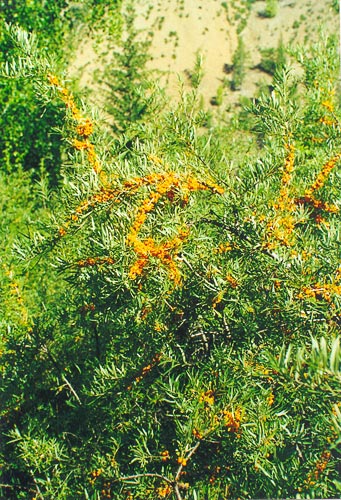Relatives
Hippophae rhamnoides L. - Common sea buckthorn.
Taxonomic position.
Family Elaeagnaceae Juss., genus Hippophae L.Morphology and biology.
Tall shrub (0.5-3.5 m tall). Roots are able to produce numerous suckers. They bear nodules that contain nitrogen-fixing bacteria. Rather short shoots with hard, sharp spines 2-7 cm long. Perennial branches are covered by yellow-brown, brown or dark brown bark. Leaves are alternate, simple, linear or linear-lanceolate, 2-8 cm long, dark grayish-green from above and yellowish silver-white from below. Orange, red or yellow berries are juicy, smooth, and glossy; drupe shape is globular, ovate or ellipsoid. Blossoms in April/May; berries ripen in August/September. Propagated by seed, layers, and root or stem cuttings. 2n = 12, 24.Distribution.
Occurs throughout the Caucasus, the Pamir-Altai region, Tien Shan, Dzungarian Ala Tau, Tarbagatai, Saur, Altai, the Sayan Mountains, the Trans-Baikal region, southern Moldova and southwestern Ukraine (Dniester, Prut and Danube river valleys), the Kaliningrad province (several islands in the Baltic Sea), Western Europe (south of Scandinavia, Atlantic Coast areas), Asia Minor, Iran, the Himalayas, northwestern China, and Mongolia.Ecology.
Hygromesophyte. Grows in river valleys in well-drained, alluvial soils of light texture, where groundwater comes close to the surface. Actively inhabits newly transported alluvial formations that remain after high floods. Resistant to low winter temperatures (survives -50╓C) and high summer temperatures (up to +40╓C), thus demonstrating good survival habit in the continental environments of Central and Middle Asia. In the Western Pamirs, this shrub grows at altitudes of up to 3,800 m above sea level. Although its natural habitats are close to river valleys and sites with superficial groundwater, under cultivation it often appears quite resistant to drought. Owing to its symbiosis with nitrogen-fixing bacteria, sea buckthorn is undemanding to soil, frequently grows in pebble beds depleted of humus, and endures certain levels of soil salinization, though it cannot withstand swamping.Utilization and economic value.
Used for food (berries). Nectariferous and medicinal plant. Berries are consumed fresh or frozen or used to prepare juice and jam. Of special value is sea buckthorn oil extracted from fresh or frozen fruit: it produces epithelizing, granulating and analgesic effect. This plant has been utilized for a long time in various types of shelterbelt afforestation, especially in the soils susceptible to wind and water erosion.References:
Atlas of medicinal plant habitats and resources in the USSR. 1983. Moscow, p. 272. (in Russian).Brezhnev, D.D., Korovina, O.N. 1981. Wild relatives of cultivated plants in the USSR flora. Leningrad: Kolos, p. 327-329. (in Russian).
Koropachinsky, I.Yu., Vstovskaya, T.N., Petrova, A.E., Nazarova, E.I. 1990. Common sea buckthorn. Biological fundamentals of protecting rare and threatened plants in Siberia. Ed. K.A. Sobolevskaya. Novosibirsk: Nauka, p.122-131. (in Russian).


